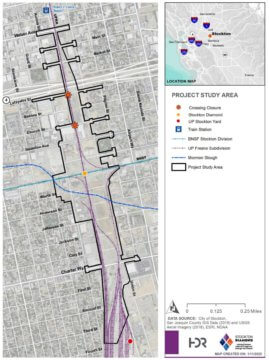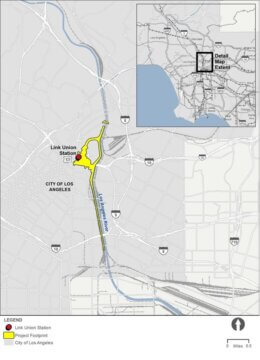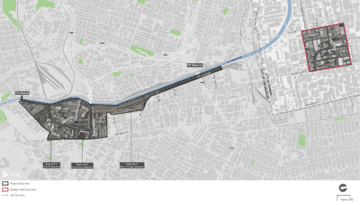Local Agency Sponsored Projects
The role of the California High-Speed Rail Authority (Authority) as federal lead agency is authorized under the Surface Transportation Project Delivery Program, otherwise known as National Environmental Policy Act (NEPA) Assignment, established in Section 327 of Title 23 of the U.S. Code, and a July 23, 2019, Memorandum of Understanding (MOU) between the Federal Railroad Administration (FRA) and the State of California (State) acting through the California State Transportation Agency and the Authority. The MOU provides that the FRA assigns, and the State assumes, the FRA’s responsibilities for compliance with NEPA, and other federal environmental laws, with respect to the railroad projects identified in the MOU, including responsibilities for environmental review, consultation and other required action. For purposes of carrying out the responsibilities assigned under the MOU, the State is deemed to be acting as the FRA. These assigned federal responsibilities are performed by the Authority, with oversight by the California State Transportation Agency and the State. The railroad projects assigned to the State in the MOU include the Authority’s projects, certain rail projects directly connected to stations on the California High-Speed Rail System and the ACEforward project within the Altamont Corridor Express system. The Stockton Diamond project is sponsored by the San Joaquin Regional Rail Commission (SJRRC) and is a part of the ACEforward suite of projects.
Project: Stockton Diamond Grade Separation
Project: Stockton Diamond Grade Separation
Project Sponsor: San Joaquin Regional Rail Commission (SJRRC)
Project Status: As of July 28, 2022, the Authority and SJRRC have completed the NEPA process for the Stockton Diamond Grade Separation Project (Project), and the Final EA and FONSI are available on the Stockton Diamond website at the link below. After the close of the 30-day public comment period for the Draft EA on April 27, 2022, the Authority and SJRRC continued the NEPA process and reviewed comments, provided responses, and prepared the Final EA. Please refer to the SJRRC project website for complete Project documents and information, including current status of all Project phases.
Website: https://stocktondiamond.com/resources/
Project Description:
The San Joaquin Regional Rail Commission (SJRRC) proposes to construct the Stockton Diamond Grade Separation Project (Project), a critical passenger and freight mobility project that would construct a grade separation of the existing at-grade crossing of BNSF Railway (BNSF) and Union Pacific Railroad (UP) freight rail lines at the existing Stockton Diamond rail intersection. The SJRRC is the lead agency under the California Environmental Quality Act (CEQA) and joint lead agency under the National Environmental Policy Act (NEPA). The California High-Speed Rail Authority (Authority) is the federal lead agency under the NEPA Assignment Program.
On August 19, 2020, SJRRC officially launched the environmental review process for the Stockton Diamond Grade Separation Project (Project) with a Notice of Preparation (NOP) for an Environmental Impact Report (EIR). When the NOP was issued, the environmental document was presented to stakeholders and the public as a joint CEQA/NEPA document. SJRRC, as the CEQA Lead Agency in coordination with the Authority as the NEPA Lead Agency, under assignment from the FRA, was to prepare an EIR/Environmental Assessment (EA). Due to funding deadline considerations, the CEQA/NEPA document was split, and SJRRC prepared an EIR for the Project, which was adopted by the SJRRC Board on June 4, 2021. SJRRC and the Authority then jointly prepared a Draft EA and Final EA for the Project in conformance with NEPA. SJRRC is the Project sponsor and joint lead agency under NEPA.
The Project is located just south of Downtown Stockton near South Aurora Street and East Scotts Avenue in the City of Stockton in San Joaquin County, California. The area of impacts is bounded by Robert J. Cabral Station to the north; the UP Stockton Yard to the south, located approximately at East Fourth Street; South Pilgrim Street to the east; and South Grant Street to the west (See Figure 1 below).
The Project would construct a grade separation of the BNSF and UP rail lines by elevating the UP mainline tracks over the BNSF mainline tracks to reduce rail congestion and allow passenger and freight rail traffic to flow uninterrupted through the crossing. Currently, the BNSF Stockton Subdivision and the UP Fresno Subdivision consist of two main tracks each, and they intersect each other at a level, at a grade crossing known as the Stockton Diamond. This rail intersection is the busiest at-grade railway junction in California. The at-grade crossing experiences substantial congestion and delays service for passengers and freight throughout the Central Valley—and for freight on the broader national network. The current, at-grade configuration of the tracks results in critical delays to passenger and freight trains in the area, including those serving the Port of Stockton. Train congestion also causes vehicle delays at roadway-rail crossings and creates potential motor vehicle, rail, bicycle, and pedestrian conflicts. Reducing those conflicts improves safety, access, and mobility for City of Stockton residents through crossing closures, as well as bike, pedestrian, and roadway improvements at multiple roadway/railway grade crossings.
The SJRRC owns and operates the Altamont Corridor Express program of passenger rail projects that connect Stockton and San Jose. The San Joaquin Joint Powers Authority (SJJPA) manages the Amtrak San Joaquins intercity passenger rail service. The current ACE and San Joaquins intercity passenger rail services are constrained by the at-grade Stockton Diamond Interlock at-grade crossing, which can reduce reliability and on-time performance for both passenger and freight rail service. The grade separation would help improve the operational performance for SJRRC and the SJJPA as they provide service between the Central Valley, Sacramento, and San Francisco Bay Area. Transit in San Joaquin County is also important to the region and includes a system of bus rapid transit, intercity and interregional bus transit services, ACE commuter rail service, and San Joaquins intercity rail service.
The reduction in rail congestion with the implementation of this Project would reduce delays for passenger and freight rail providers, improve freight mobility, reduce travel times, and increase safety for motor vehicle, bicyclist, pedestrian, and train traffic. It also would reduce locomotive and automobile idling and air emissions.
The Project’s public benefits would extend to motorists, pedestrians, rail passengers, freight shippers, and residents throughout the region. Additional benefits would include reduced fuel consumption, lower freight rail transportation costs, and improved travel times and reliability. As described and explained in the EA, the Project would result in overall beneficial effects on long-term air quality, traffic and transportation, and visual quality and aesthetics in the Project Study Area.
FIGURE 1. PROJECT STUDY AREA
Project: Link Union Station
Project: Link Union Station (Link US)
Project Sponsor: Los Angeles County Metropolitan Transportation Authority (Metro)
Project Status: On June 21, 2024, the California High-Speed Rail Authority (Authority) and Metro released the Draft Environmental Impact Statement/Supplemental EIR (EIS/SEIR) for a 45-day public review and comment period in accordance with the National Environmental Policy Act (NEPA) and California Environmental Quality Act (CEQA). The 45-day public review and comment period began on June 21, 2024 and ended on August 9, 2024. The comment period has closed.
OPEN HOUSE AND PUBLIC HEARING: Metro held an open house and public hearing on July 9, 2024, to explain the Project and the Draft EIS/SEIR analysis.
Please refer to the Link US project website for complete Project documents and information.
Website: https://linkunionstation.com/
Website: https://linkunionstation.com/
Project Description: Metro is proposing the Link US Project to address existing capacity constraints at Los Angeles Union Station (LAUS). The Project consists of transforming LAUS from a stub end tracks station into a run-through tracks station by extending ten platform tracks south of LAUS Platforms 2 through 6 that would merge into a minimum of four tracks on the U.S. Highway 101 (US-101) viaduct and continue south to connect to mainline tracks along the west bank of the Los Angeles River, replacing the existing pedestrian passageway under the LAUS platforms and tracks with a new expanded passageway, and establishing 10 new run-through tracks for regional/intercity trains and future high-speed rail trains south of LAUS. The Project also includes off-site railroad improvements to BNSF Railway’s Malabar Yard in the City of Vernon. The Malabar Yard railroad improvements consist of the closure of the 49th Street at-grade railroad crossing and a new track connection between two existing track segments along 46th Street in the City of Vernon. Metro is the lead agency under CEQA and joint lead agency under NEPA. The Authority is the federal lead agency under the Federal Railroad Administration (FRA) NEPA Assignment Program.
In May 2016, pursuant to the requirements of NEPA and CEQA, FRA (federal lead agency at the time) and Metro issued a Notice of Intent/Notice of Preparation to prepare a joint EIS/EIR for the Link US Project. In October 2018, Metro elected to prepare a standalone Environmental Impact Report (EIR) in compliance with CEQA and certified the Final EIR on June 27, 2019. In October 2021, Metro approved CEQA Addendum No.1 to the Final EIR. Since certification of the Final EIR and approval of the CEQA Addendum, there have been minor additions or changes to the Project, which requires the preparation of a Supplemental EIR. Therefore, in April 2023, the Authority and Metro agreed to prepare a joint EIS/Supplemental EIR to complete the NEPA and CEQA process. The final EIS/SEIR is expected in early 2025.
The Project is located in Downtown Los Angeles in the vicinity of LAUS (see Figure 1 below). LAUS is located at 800 Alameda Street in the City of Los Angeles, California. LAUS is bounded by US-101 to the south, Alameda Street to the west, Cesar Chavez Avenue to the north, and Vignes Street to the east. The Project extends from the northern terminus at North Main Street to the southern terminus south of First Street in the City of Los Angeles.
The Link US Project comprises several key components:
- New lead tracks with an elevated rail yard with new platforms and canopies
- New concourse-related improvements, including a 140-foot-wide expanded passageway below the rail yard with new escalators and elevators
- New run-through tracks south of the LAUS over US-101
- Accommodation of the Authority’s planned high-speed rail (HSR) system on common rail infrastructure to support future HSR trains
- New rail communications, signals, and safety improvements
At the BNSF West Bank Yard, dedicated lead tracks for Amtrak trains and BNSF trains, in combination with implementation of common rail infrastructure would result in permanent loss of freight rail storage track capacity at the north end of BNSF West Bank Yard (5,500 track feet). As proposed mitigation to offset the permanent loss of freight storage tracks at the BNSF West Bank Yard, Metro would implement two railroad improvements at BNSF’s Malabar Yard in the City of Vernon, as described below (see Figure 2 below) :
- Closure of the at-grade railroad crossing at 49th Street; and
- New 1,000-foot track connection along 46th Street between Pacific Boulevard and Seville Avenue.
The Project’s benefits include increasing regional/intercity rail capacity, improving transit connectivity, enabling one-seat rides on the regional/intercity rail systems across Southern California and accommodating the planned HSR system at LAUS.
FIGURE 1. PROJECT LOCATION
Figure 2: Link Union Station Project Study Area and Malabar Yard Study Area
- NEPA Assignment MOU
- Local Agency Sponsored Projects
- Environmental Mitigation & Commitments
- Programmatic Environmental Documents (Tier 1)
- Project Section Environmental Documents (Tier 2)
- Special Project Environmental Documents
- Project Level Environmental & Engineering Guidelines, Studies & Reports
- Stormwater Management
PROJECT SECTION DETAILS
Select a project section to learn more:
CONTACT
Environmental
(916) 324-1541
info@hsr.ca.gov




